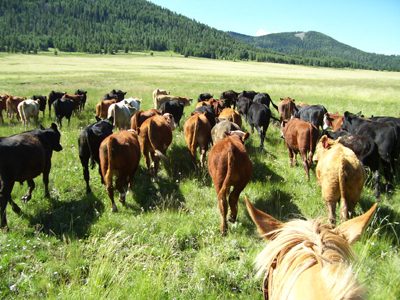Using a Supplementation Program as a Grazing Management Tool
Guide B-818
Manny Encinias, Sam Smallidge
College of Agricultural, Consumer and Environmental Sciences, New Mexico State University
Authors: Extension Livestock Specialist and Extension Wildlife Specialist, respectively, Department of Extension Animal Sciences and Natural Resources, New Mexico State University. (Print Friendly PDF)
Beef producers in the Southwest are commonly challenged to balance forage supply and demand on their grazing operations. A tenured manager is always aware of the grazing use patterns within and across pastures on a ranch. Regardless of the year, most managers would like to get more grazing days out of a given pasture by improving grazing utilization in those areas not commonly preferred by cattle.
Pasture attributes–such as distance to water, slope, cross-fencing, shade/wind cover, and grass species composition–coupled with the grazing behavior of cattle provide the basis for grazing use patterns across pastures. Undoubtedly, water developments and cross-fencing provide managers long-term solutions to improve grazing distribution by cattle. However, evaluating how, when, where, and what type of supplements to deliver to cattle can provide lower-cost opportunities to change grazing behaviors, subsequently producing more grazing days and reducing overuse (i.e., grazing and loafing) of conveniently located grazing areas within a pasture.
Training cattle to the supplement of choice. A key principle in using supplements as a grazing management tool is to establish a training period to help cattle acquire a taste of the supplement and understand the delivery or placement system. Best success has come from establishing a two-week training period, but this period may be longer or shorter depending on the cattle. The importance of breaking cattle to the supplement and delivery system cannot be overemphasized.
Identify underutilized areas. There is no doubt that delivering supplements to watering locations and/or to the locations where cattle are found within a pasture is convenient for both the cattle and producer. However, identifying underutilized areas within a pasture and supplementing in these areas will benefit cattle by meeting nutritional deficiencies and also extend the grazing resources by extending the perimeter of grazing between water and the site of supplementation.

Figure 1. Delivering cattle to an underutilized area for supplementation.
Delivering cattle to underutilized areas. Data collected across various production environments in the Southwest suggest the most effective time during the day to deliver cattle to underutilized areas for supplementation is the period after daily watering and before the cattle begin to graze in the late afternoon (Figure 1). The later in the day cattle are delivered to the desired grazing areas the more grazing time and time overall cattle will spend in these areas. Early in the day prior to daily watering is the least effective time to deliver cattle to these areas if the goal is improving grazing time and distribution. Initially, it will take some adjustment from both the cattle and the individual delivering the supplement/cattle to accept the different supplementation schedule. However, the cattle will become accustomed to this schedule and anticipate the general location, as well as the concept of being supplemented in the afternoon.
Impact of supplement type. The type of nutrient delivered (i.e., energy, protein, trace minerals, salt) in relation to nutrient availability in the grass and the nutrient requirements of the cattle will impact the effectiveness of this strategy. In addition, self-fed supplements (i.e., blocks, tubs, liquid, and loose mineral) result in more total visits per week and greater grazing use in underutilized areas than do supplements delivered multiple times per week by truck or horseback (i.e., hand-fed).
Will this concept work on your operation? The simple answer is if you want it to work, it will. On some operations it can be debated who is more difficult to train to the concept, the cattle or the crew. The concept will not be as effective if 100% of the crew is not on board from the get-go. Involving the crew early in the discussions and design of your system is recommended as it not only brings more perspective to your grazing distribution plan but, as a manager, you will also acquire much needed buy-in to the new concept.
Patterns of available forage throughout the Southwest will always challenge the creative ability of producers to stretch their grass supplies throughout the year. Avoid overuse of convenient grazing locations by delivering supplements to underutilized areas within a pasture. It's a slightly different philosophy of supplement delivery than traditional methods, but it has worked successfully across various landscapes and conditions.
To find more resources for your business, home, or family, visit the College of Agricultural, Consumer and Environmental Sciences on the World Wide Web at pubs.nmsu.edu
Contents of publications may be freely reproduced for educational purposes. All other rights reserved. For permission to use publications for other purposes, contact pubs@nmsu.edu or the authors listed on the publication.
New Mexico State University is an equal opportunity/affirmative action employer and educator. NMSU and the U.S. Department of Agriculture cooperating.
Printed and electronically distributed December 2009, Las Cruces, NM.


